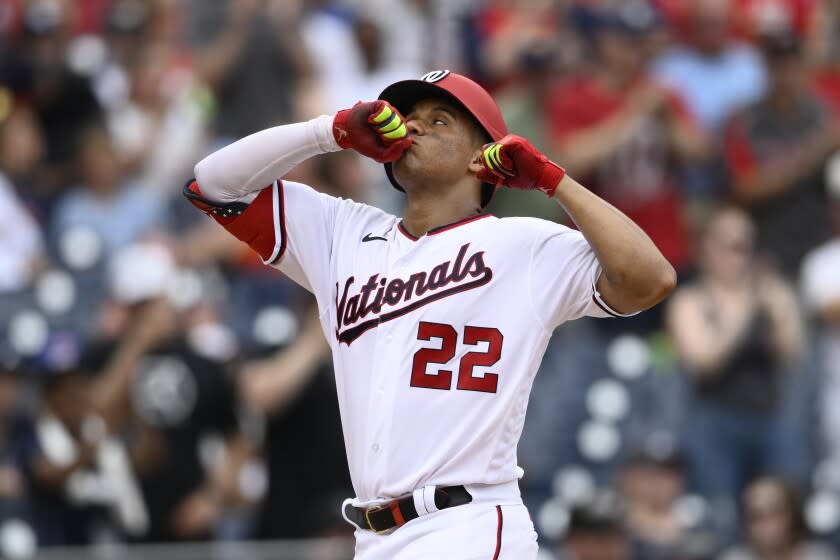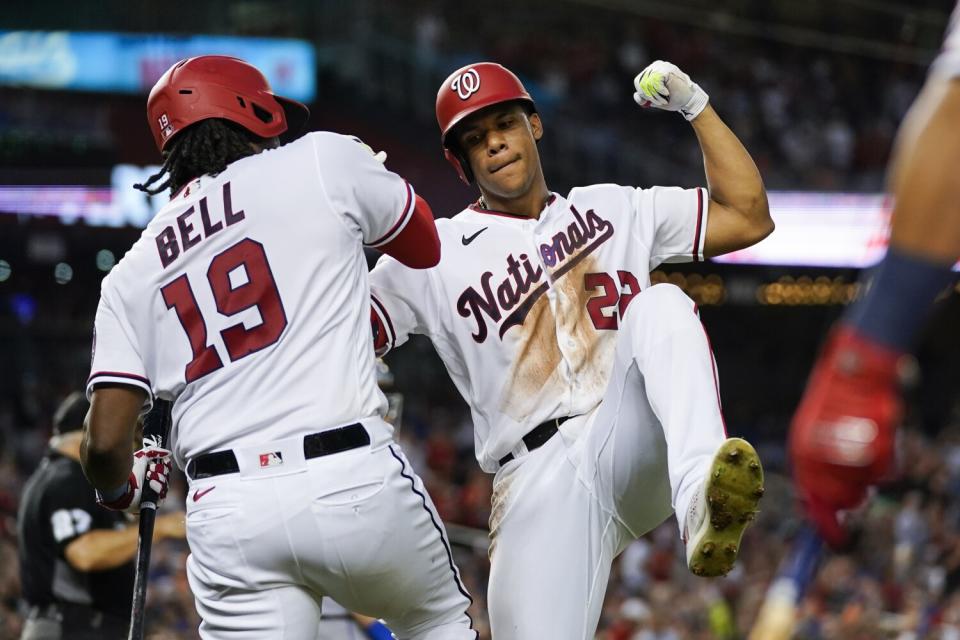Plaschke: Dodgers whiff and Padres win at trade deadline

It was Trade Deadline Day, otherwise known as Andrew Friedman Appreciation Day, a day usually rollicking with the popping of corks and slapping of backs.
Yet for a Dodgers organization that generally wallops every transaction out of the park, Tuesday was filled with a strange, solitary sound.
It was the swish of a strikeout.
This time, Goliath didn’t pillage. This time, the rich didn’t get richer. This time, the mighty Dodgers got, well, Padre’d.
Is that a word? It should be.
By allowing themselves to be outbid by their San Diego neighbors for the great, young Juan Soto, the Dodgers got Padre’d.
By failing to acquire a capable arm beyond middle reliever Chris Martin while their San Diego pals traded for baseball’s best closer in Josh Hader, the Dodgers got Padre’d.
By acquiring another underwater hitter in Joey Gallo while their San Diego friends added steady swinging Josh Bell, the Dodgers got Padre’d.
No, the Dodgers aren’t going to blow their double-digit lead in the National League West to that second-place team in the funny uniforms. The Dodgers have baseball’s top-ranked pitching staff and second-ranked offense. They’re not folding. Yes, the Dodgers can still win the World Series with their current roster, and probably should.
But make no mistake, this trade opens a three-year window on the Padres' championship hopes, with the 23-year-old Soto being under club control for three pennant races. At the same time, it slightly closes the window on a Dodgers team that this winter will grow a little older, a little creakier, and could lose one of their co-MVPs, Trea Turner, to free agency.
And what if … this October … the Padres survive the newfangled wild-card round and somehow meet the Dodgers in the divisional or league championship series? And what if they play a winner-take-all game?
The Dodgers will be led by their all-world foursome of Mookie Betts, Turner, Freddie Freeman and Will Smith. But the Padres can now counter with a foursome of Fernando Tatis Jr., Manny Machado, Soto and Bell.
The Dodgers have the starting pitching advantage, but not by much, especially when you consider their Hall of Famer Clayton Kershaw is fragile, their ace Walker Buehler is injured, their fan favorite Julio Urías is inconsistent, and their stopgaps Tony Gonsolin and Tyler Anderson aren’t playoff proven.
The Dodgers then might have to close with a rickety Craig Kimbrel, while the Padres will finish with the heat from Hader.
In a one-game series, who you got?
Don’t answer that.
“They made their team way better in the last couple of days and we look forward to that competition,” Dodgers baseball boss Friedman said of the Padres on Tuesday during a conference call with reporters.
The idea that these Padres were even in the Dodgers’ league was unthinkable just a few days ago, but their general manager, A.J. Preller, emptied his pockets for the Nationals to get Soto and apparently outbid a rich and deep organization that should never be outbid by anyone for anything.

Friedman usually owns this day, remember? Yu Darvish, Manny Machado, Max Scherzer and Turner, remember? And then there was the offseason trade for Betts.
Does any casual fan remember all of the prospects traded for those players? History will show that it is almost always worth it to trade kids for superstars. In Soto’s case, he is both a kid and a superstar, a unicorn of a player who was traded only because he wasn’t going to accept the rebuilding Nationals’ contract offer of 15 years at $440 million.
Soto was a once-in-a-lifetime acquisition, and while the Dodgers didn’t exactly need him, they certainly didn’t need him to go to one of their division rivals.
It might be the biggest gamble of Friedman’s illustrious career here that this was allowed to happen.
“Our track record would suggest that obviously we would have been aggressive in trying to figure something out,” Friedman said.
But he admitted that with the team playing so well, his past willingness to give up their best prospects was somewhat lessened.
”We felt really good about the team that we have in place,” he said, later adding, “We have a really special dynamic in that room right now, it’s something that we’re cognizant of.”
Understood. But if they weren’t going to chase Soto with their elite prospects like catcher Diego Cartaya, pitcher Bobby Miller and third baseman Miguel Vargas — who was just brought to the big leagues Tuesday — then why didn’t they go elsewhere for some starting pitching depth? Why not make a serious run for Cincinnati’s Luis Castillo, who ended up with the Seattle Mariners? Or bring back home Frankie Montas, who became a New York Yankee?
Friedman feels they will add plenty of pitching when several powerful arms return in the next six weeks from injury to join newly active Andrew Heaney. He’s talking about the likes of Dustin May, Blake Treinen, and, perhaps, even longshot Buehler.
“With some combination of arms we have potentially coming back … it spoke to having a high bar,” he said. “We felt really good about the potential of what our pitching staff can look like in October.”
Yet that’s another gamble, particularly with the rotation. In the next two months, the problems at the back of the bullpen can be fixed with several revolving relievers, but the issue at the front of the rotation remains uncertain.
“I feel good about the team that we have in place and the way they have performed,” said Friedman. “If we have an acute need, you’ll see us be more on tilt. I feel good about how aggressive we were.”
But were they aggressive enough? The answer will come in October. The Padres will be waiting.
This story originally appeared in Los Angeles Times.

